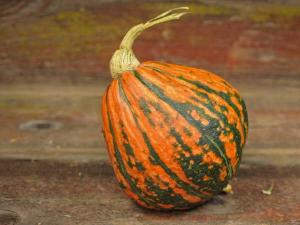Let your Lakota squash ripen fully on the vine before you harvest
They call rocks “grandfathers” because they are older than any of us. They gave us heroes such as Crazy Horse and Sitting Bull. They are the “Lakota” or “Dakota” Native American tribe. Both “Lakota” and “Dakota” are just different pronunciations of the same tribal name, a name that means “the allies.” We refer to them as “Sioux,” which is a shortened form of the Ojibwa name of “Nadouwesou” which means “adders” or “snakes.”
Besides a rich history, the Lakota give us the Lakota Squash (Cucurbita maxima), a brilliantly colored, pear-shaped winter squash. The fruits are decorative with their deep red background streaked with green flames. This beauty makes them ideal for fall decorations. And the orange, fine-grained, nutty flesh is a sweet winter treat equal to if not better than Hubbard squash. Many winter squash are huge, weighing in at 20 pounds or more, but the Lakota squash is a more manageable five to eight pounds.
Like all Cucurbita maxima squash, Lakota squash are descended from South American wild Cucurbita andreana over 4,000 years ago. Plant this heirloom squash in a garden spot with full sun and rich soil. Dig the earth down a good foot deep. Add in lots of organic matter such as compost or well-rotted manure.
Sow the seeds an inch deep after all danger of frost has passed and the soil is thoroughly warm. Put about four seeds into a mound or hill. This will let that patch of soil heat up faster than the surrounding soil and speed up germination. The hill will also allow good drainage so the seeds won’t rot.
These are vigorous, sprawling vines that can reach 20 feet long or more, so leave four to five feet between hills, and space the rows a good six feet apart. The vines have tendrils that let them grasp supports and climb. Because the fruits are relatively light at five to eight pounds, you can even train these vines up a trellis or overhead on a pergola.
Keep the planting bed well watered but not soggy. Seeds should germinate in 10 to 14 days. Once the vines begin to flower, you can side dress with a good organic fertilizer. This is done by spreading the fertilizer in a band a few inches away from the main stem. Lightly rake the fertilizer into the soil and water well. You can use a commercial fertilizer with a rating of 10-10-10.
Let your Lakota squash ripen fully on the vine before you harvest. You should have mature squash in 80 to 100 days from planting. Avoid working in the squash patch when it is wet because you can spread fungal diseases.
Seeds are widely available from local nurseries, or mail order from companies such as Baker Creek (www.rareseeds.com). As with all hard-shelled winter squash, you can test whether it is fully ripe by gently pressing a fingernail into the skin. Only pick when the skin doesn’t dent from your fingernail. The more mature the squash, the harder the shell. Don’t let it sit too long in the garden or it will begin to dry out.
Always cut the squash from the vine with a knife rather than just pulling it off by hand. This leaves a bit of the stem attached and prevents rotting in storage. Pick all squash before the first killing frost in the fall. Avoid bruising or damaging the squash before storing or they will spoil faster. Lakota squash will keep until spring if stored in a cool, dry area out of direct sunlight.
Lakota squash can be baked with a bit of maple syrup or made into hearty soups. You can sweeten the flesh, add eggs and spices, and bake into a “pumpkin” pie. Even the flowers are delicious eaten as fritters. Also, the seeds are edible. The high-protein seeds are rich in minerals, and can be eaten raw or lightly toasted in a cast iron pan on the stovetop. You can even press the seeds for a nutritious oil. Some cultures eat these toasted seeds to kill intestinal parasites.
Take a bite out of history and plant the easy-to-grow and beautiful Lakota squash. It will give you a Dakota pipeline of sorts to delicious meals from a tradition that is nearly as old as “grandfathers.”























































